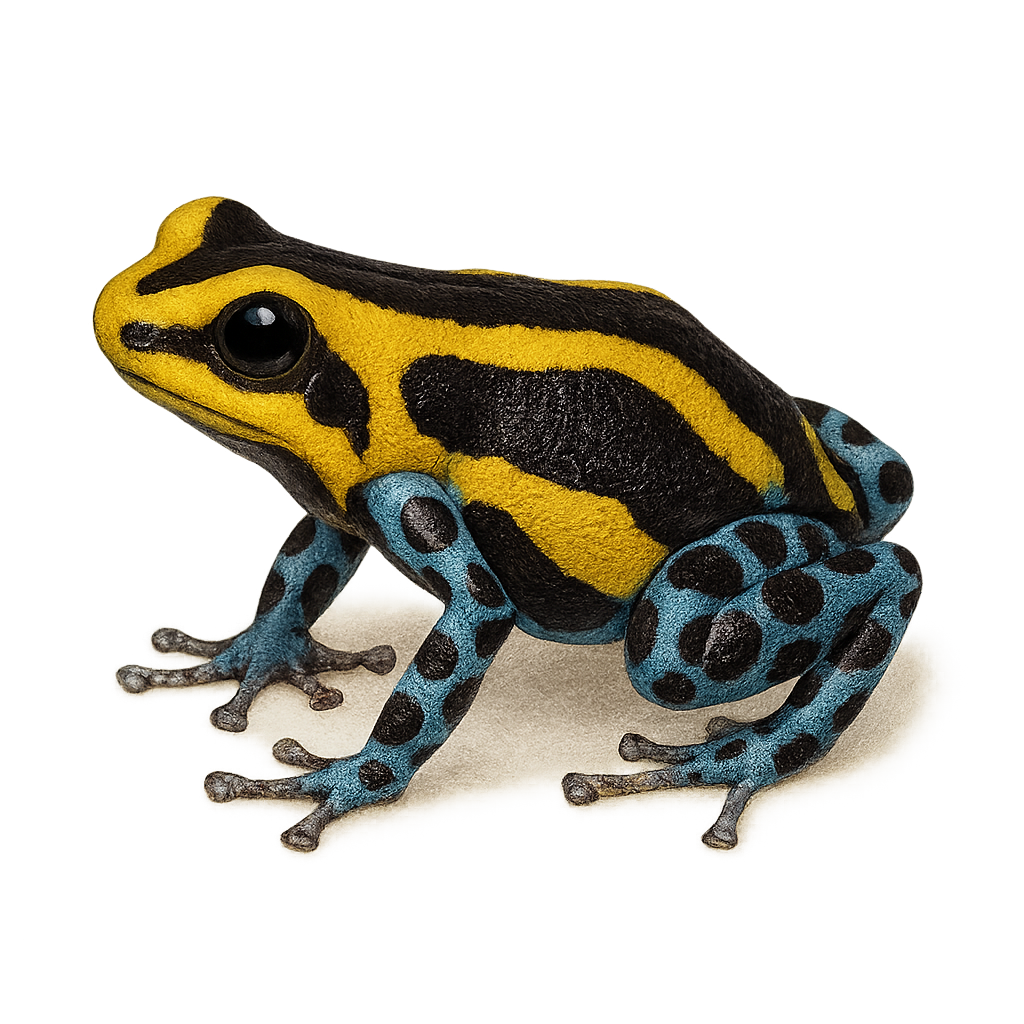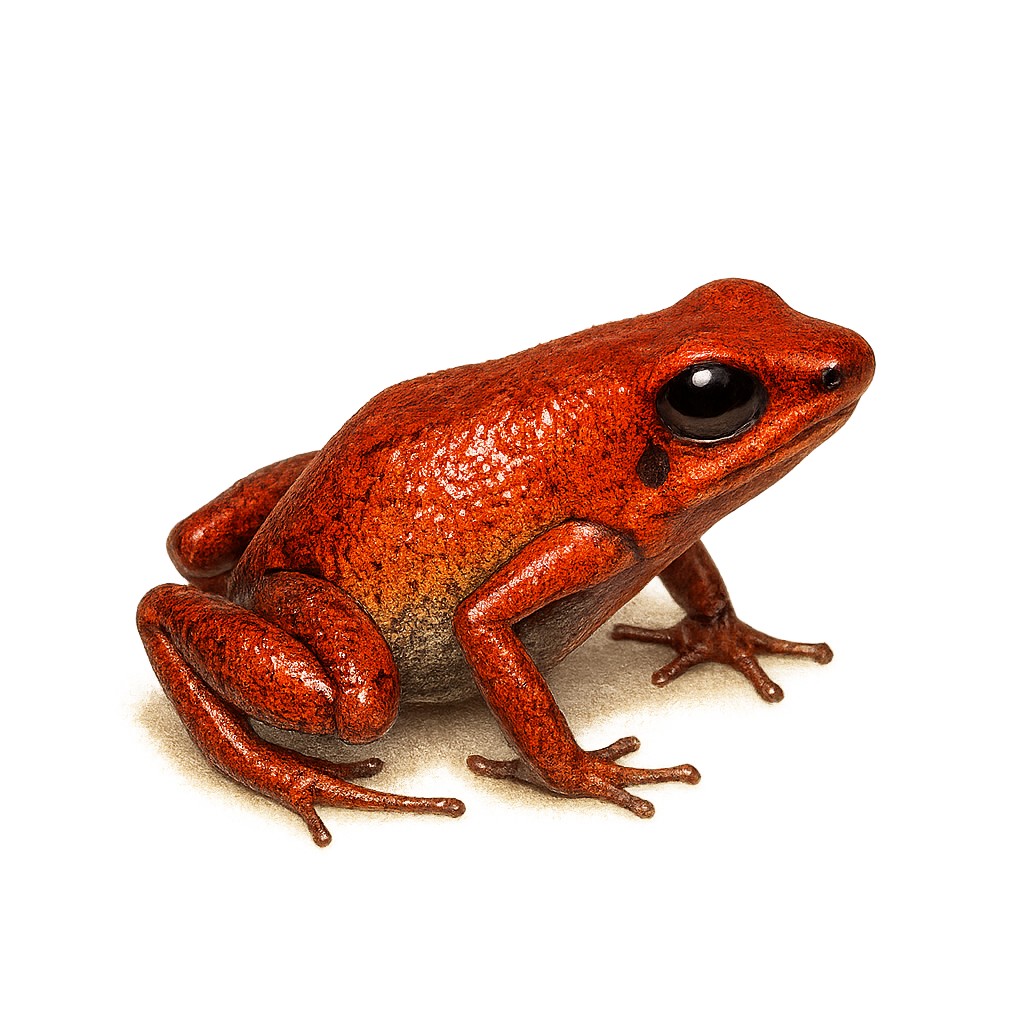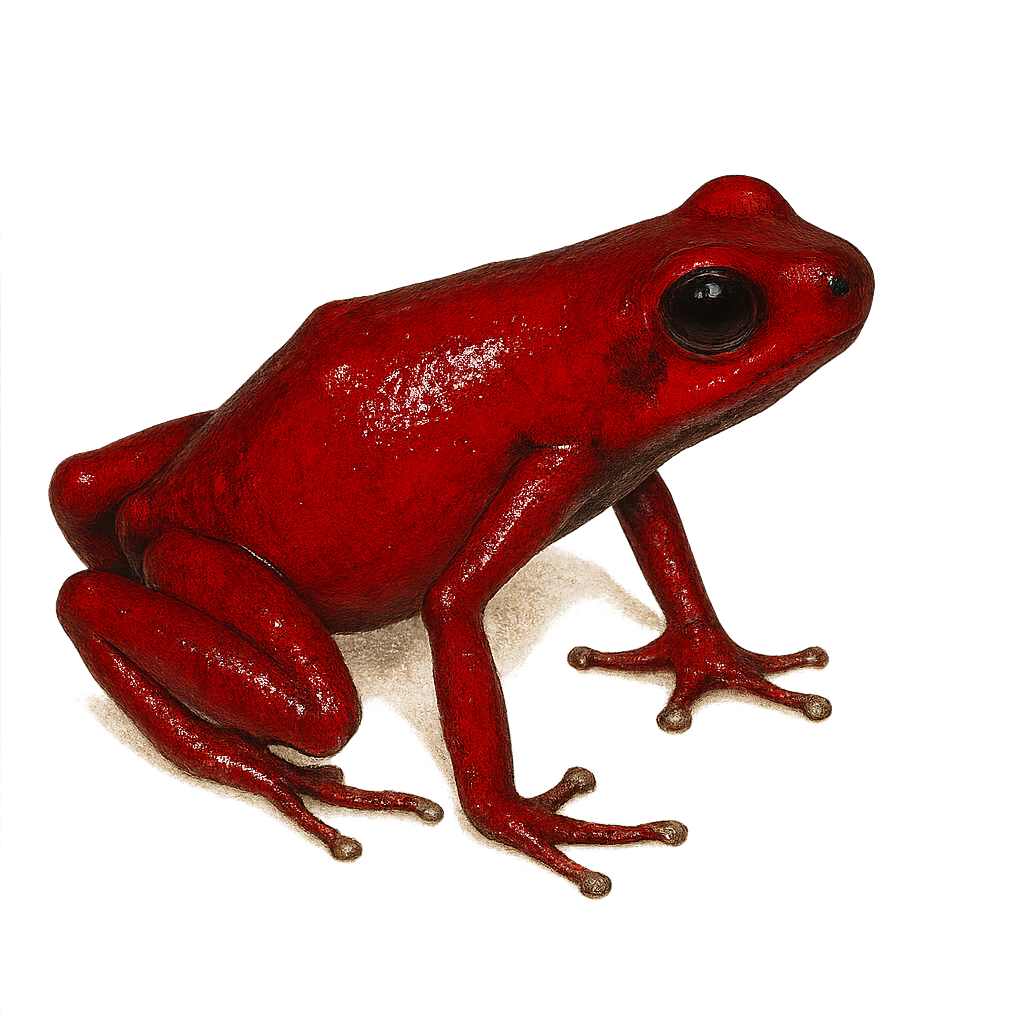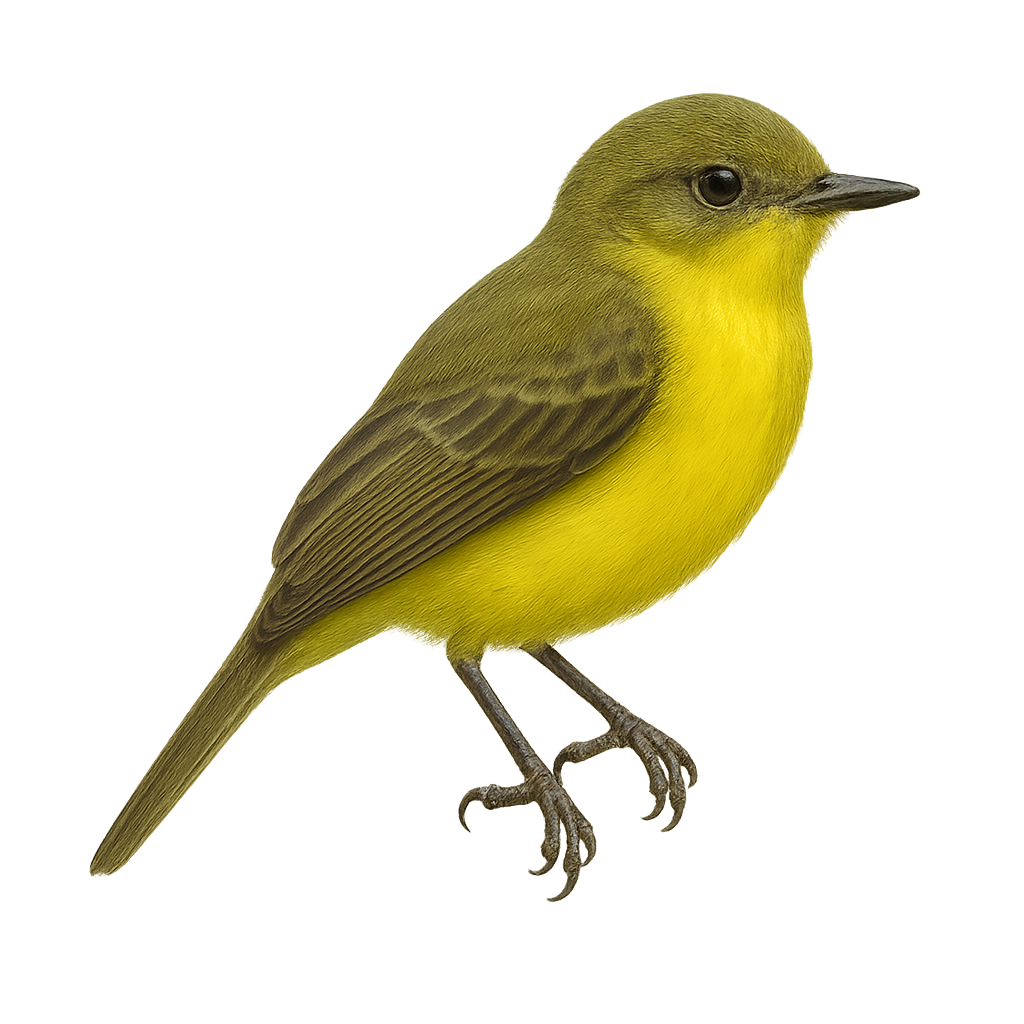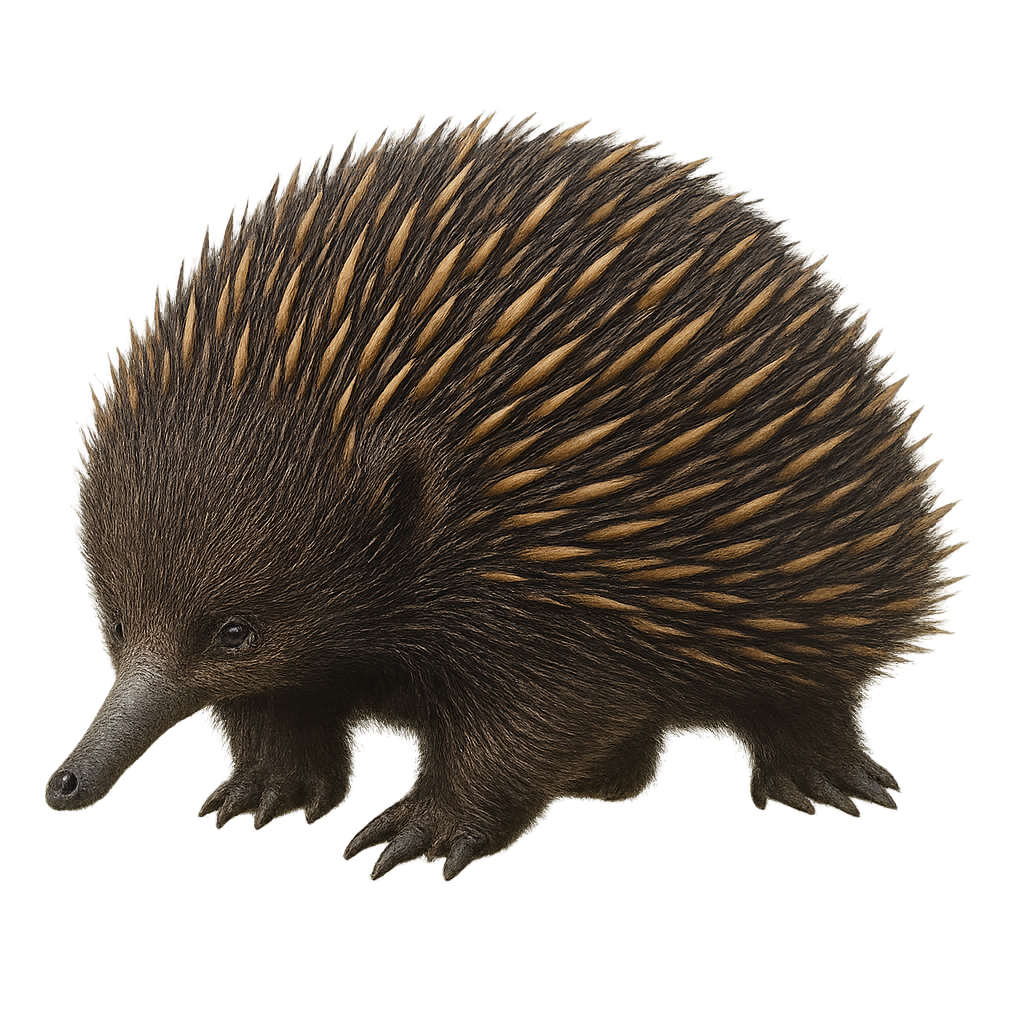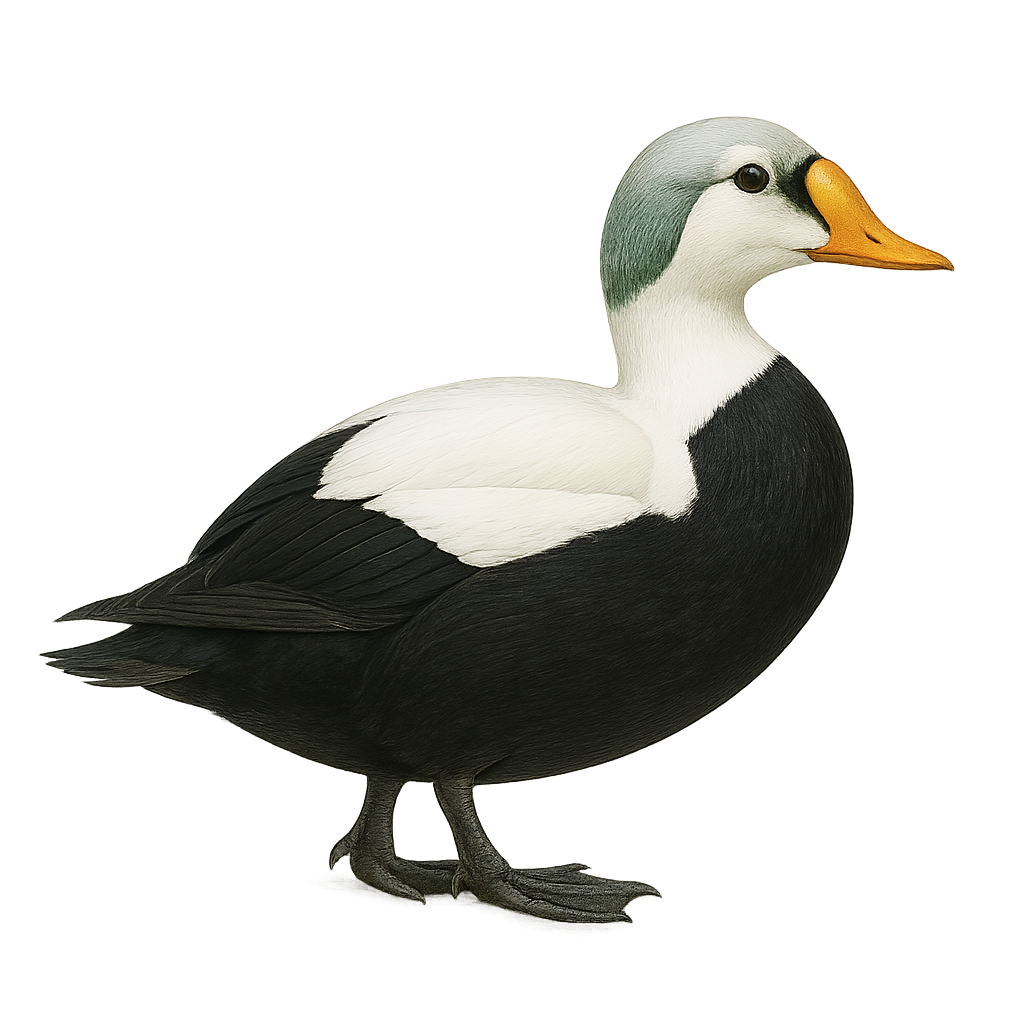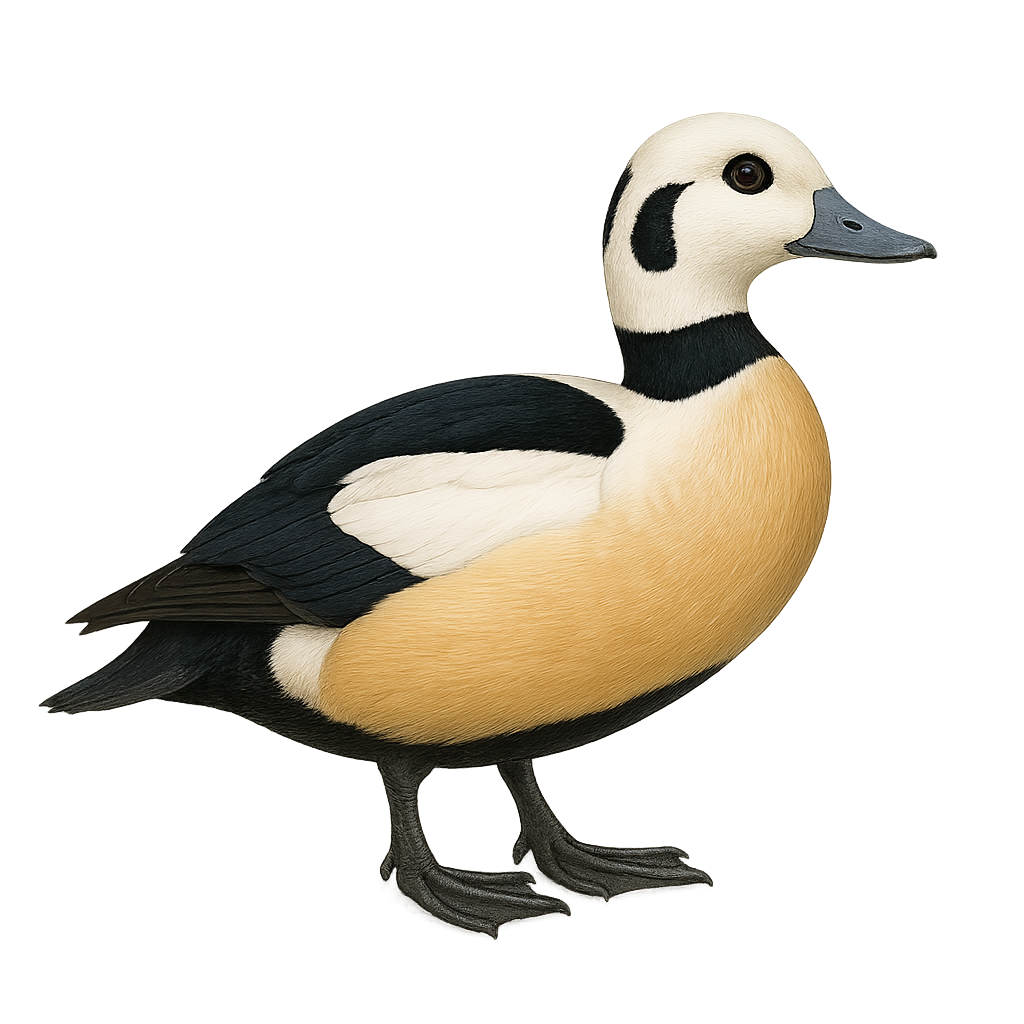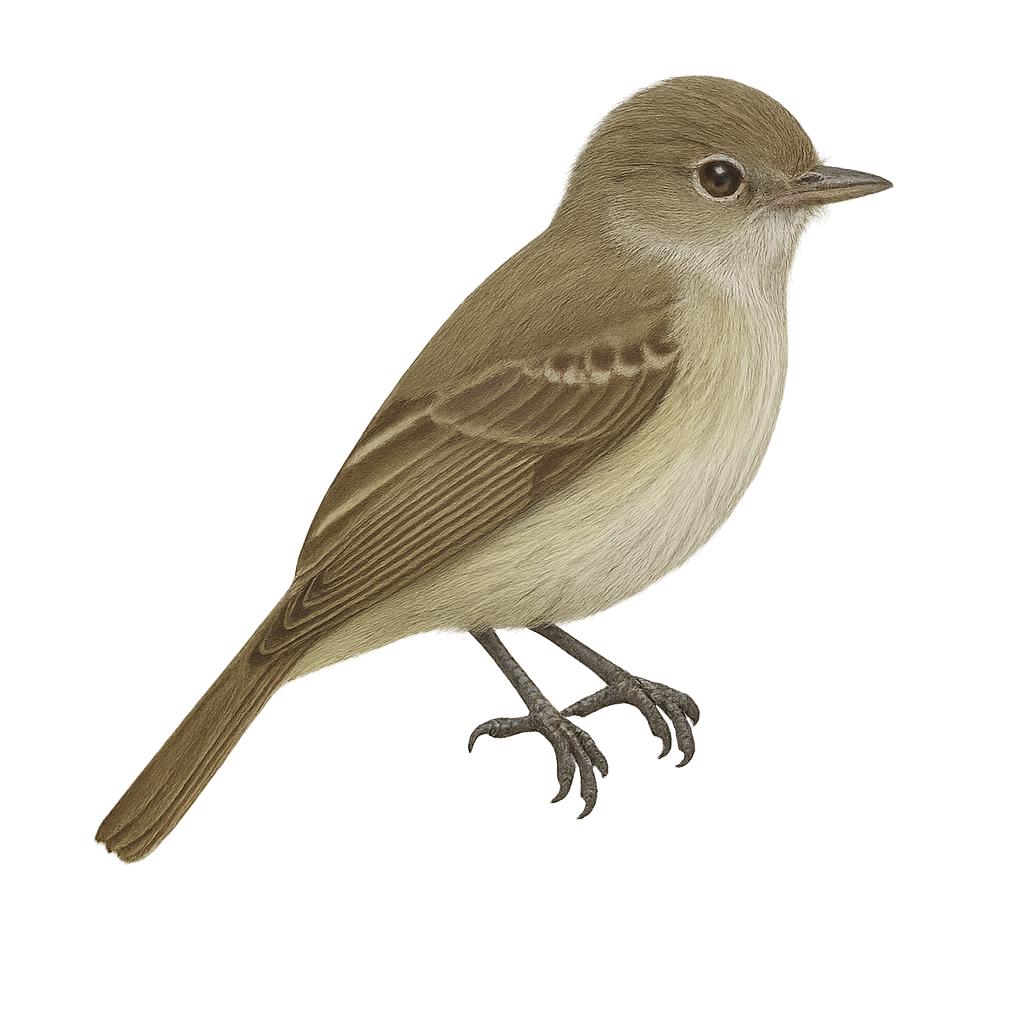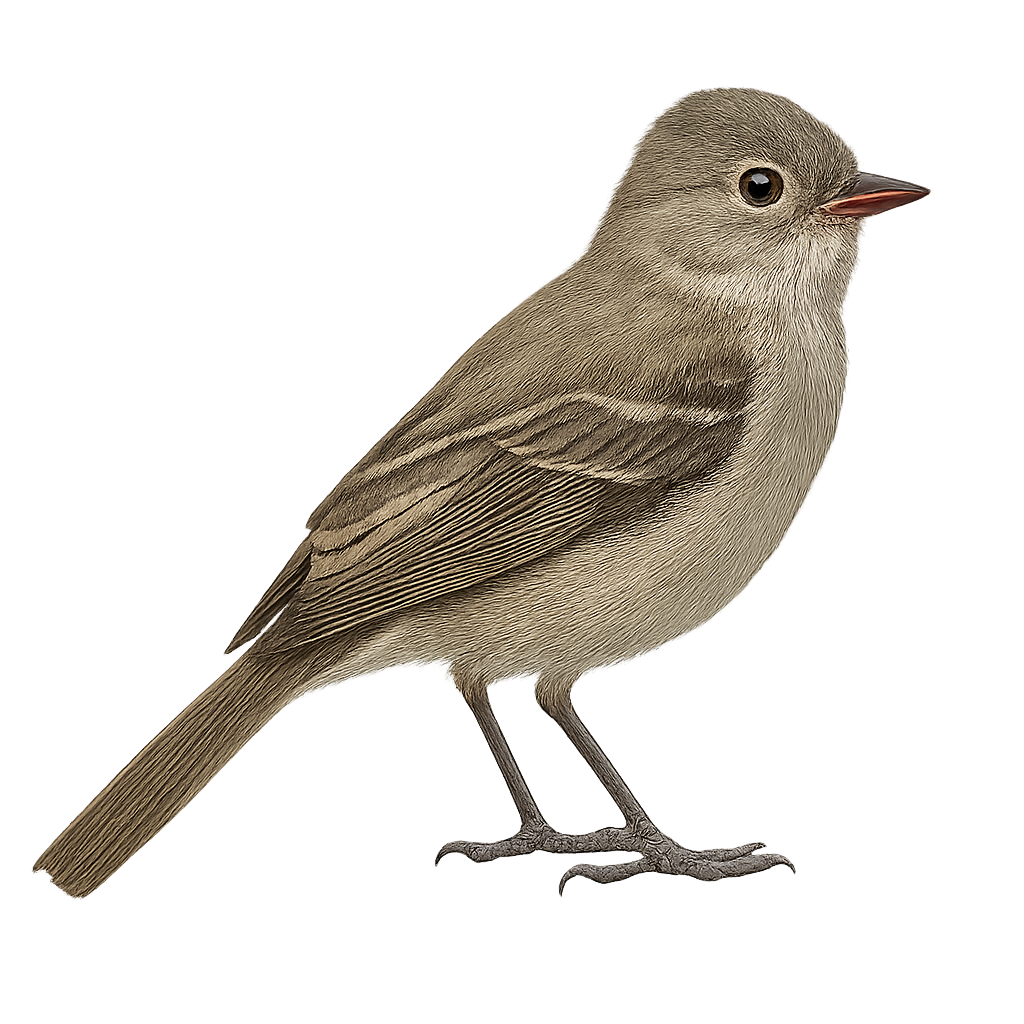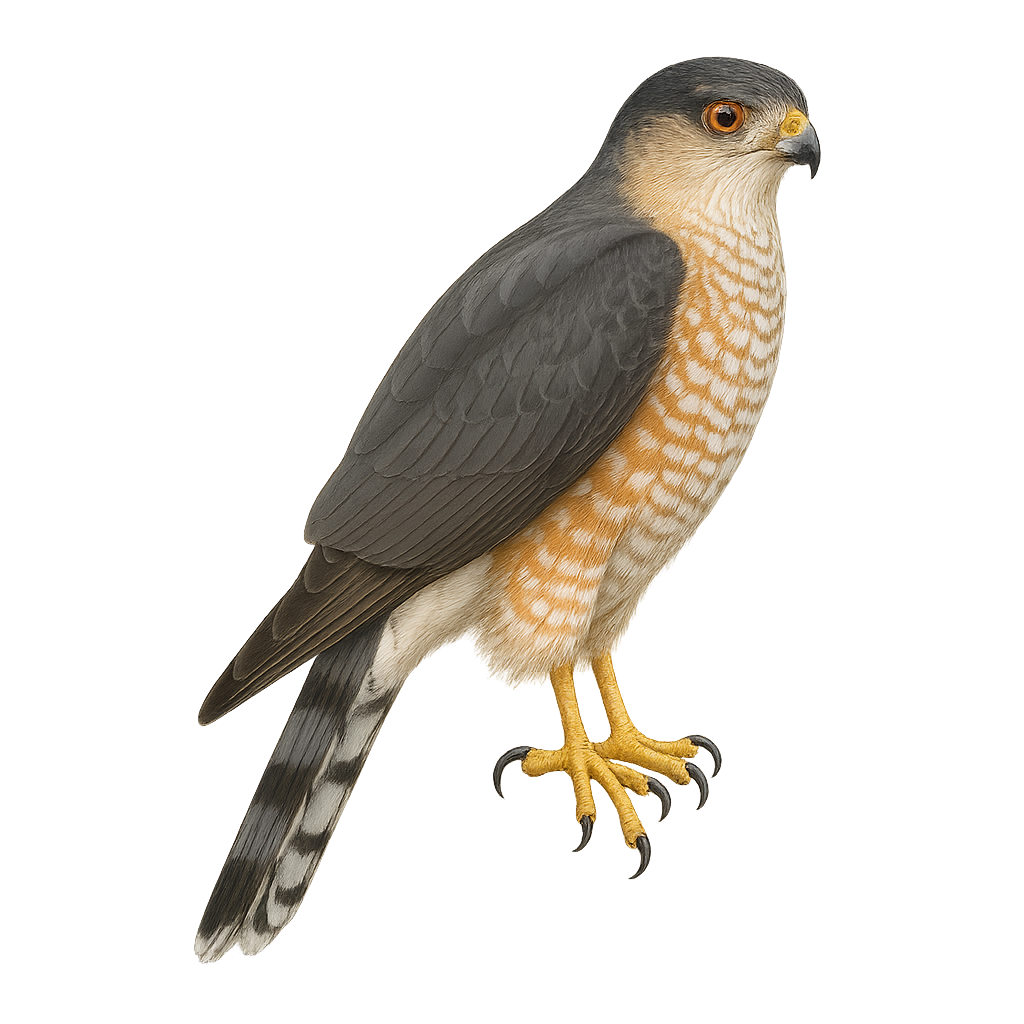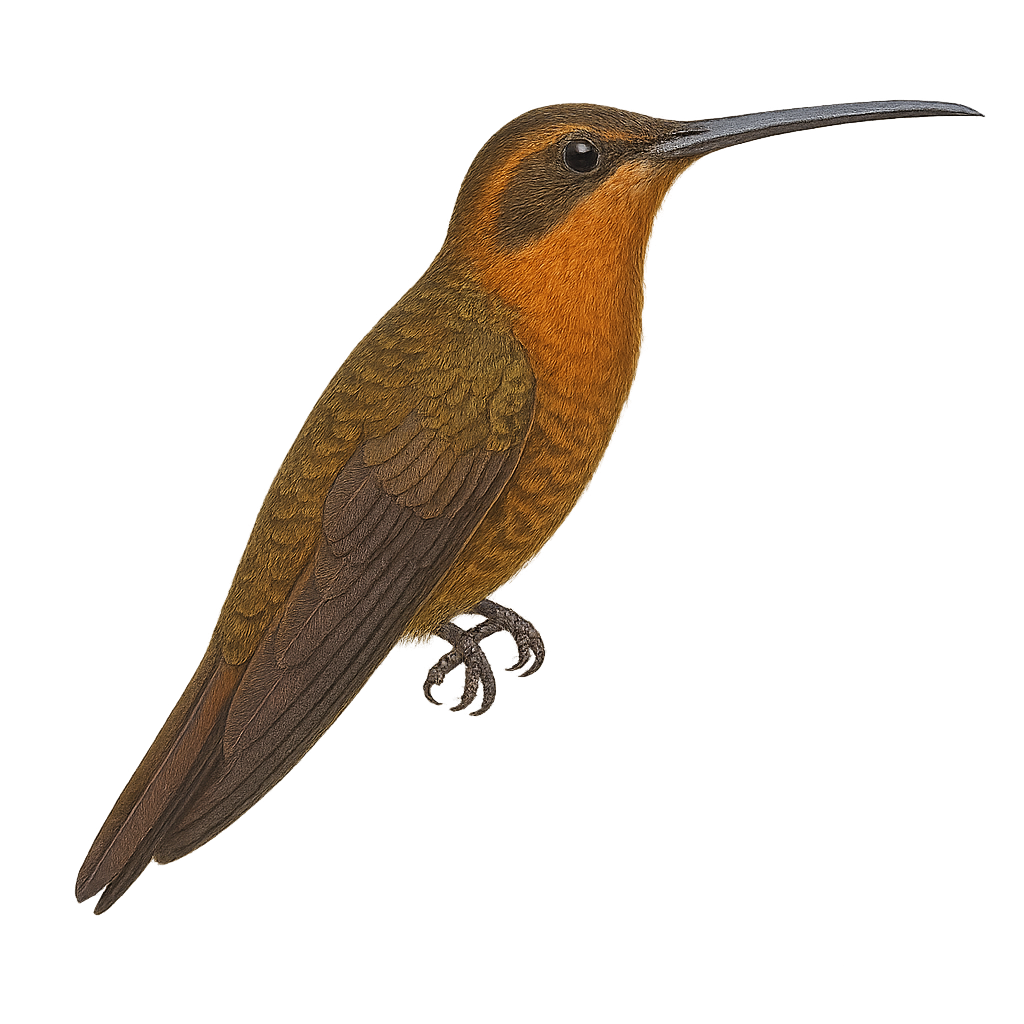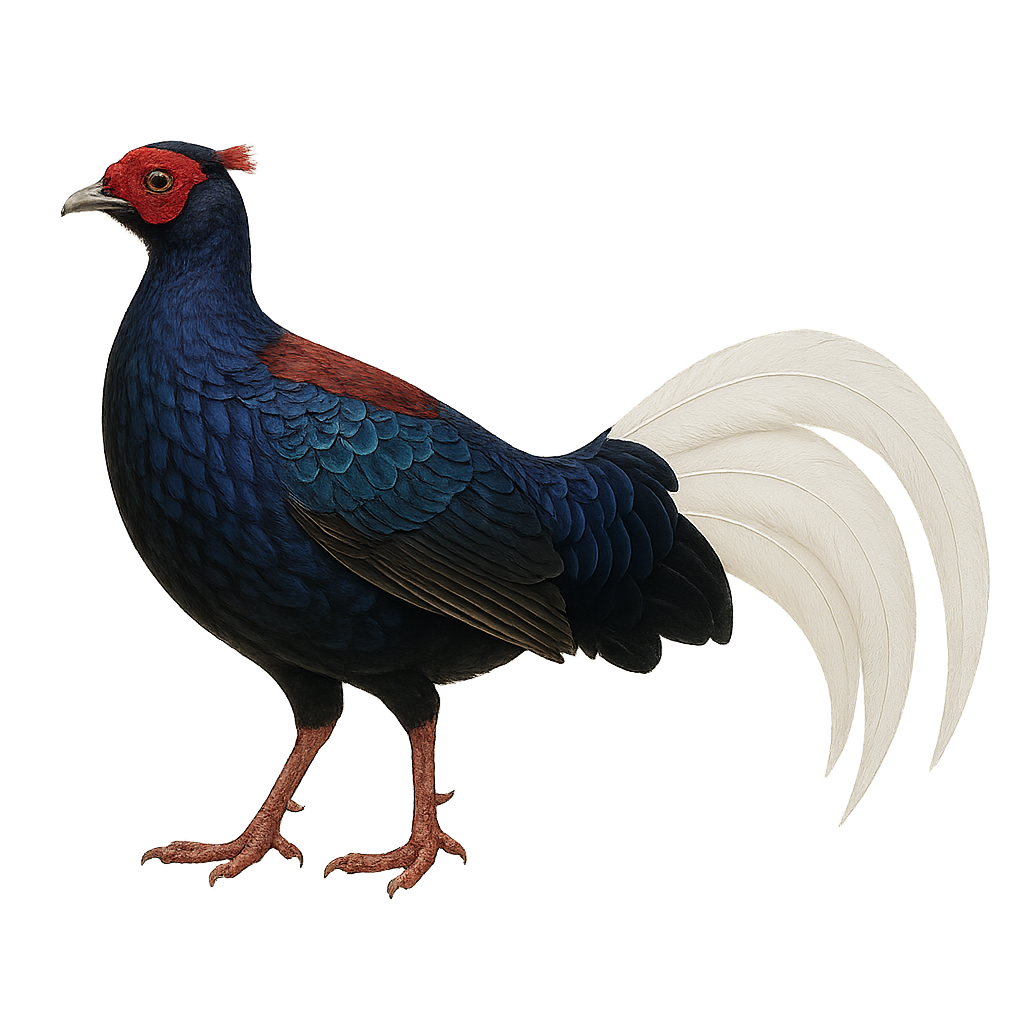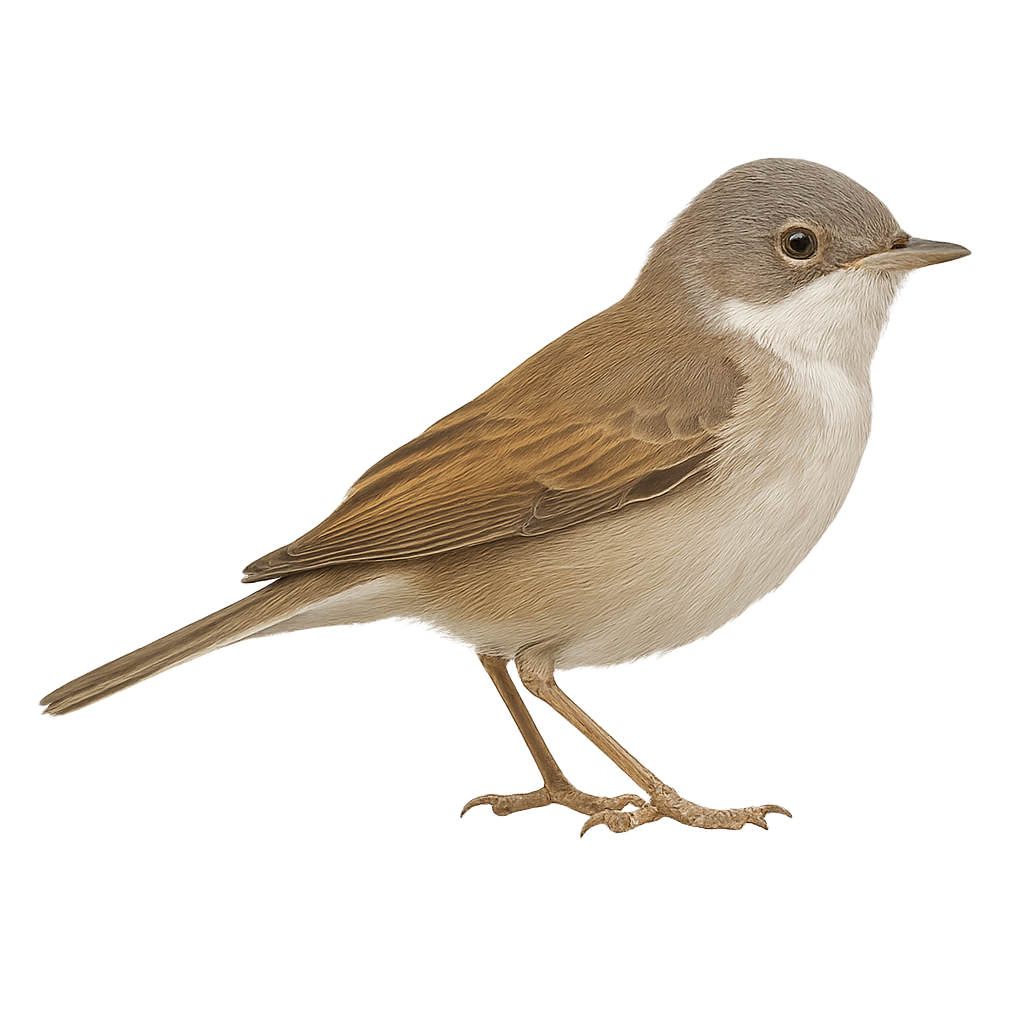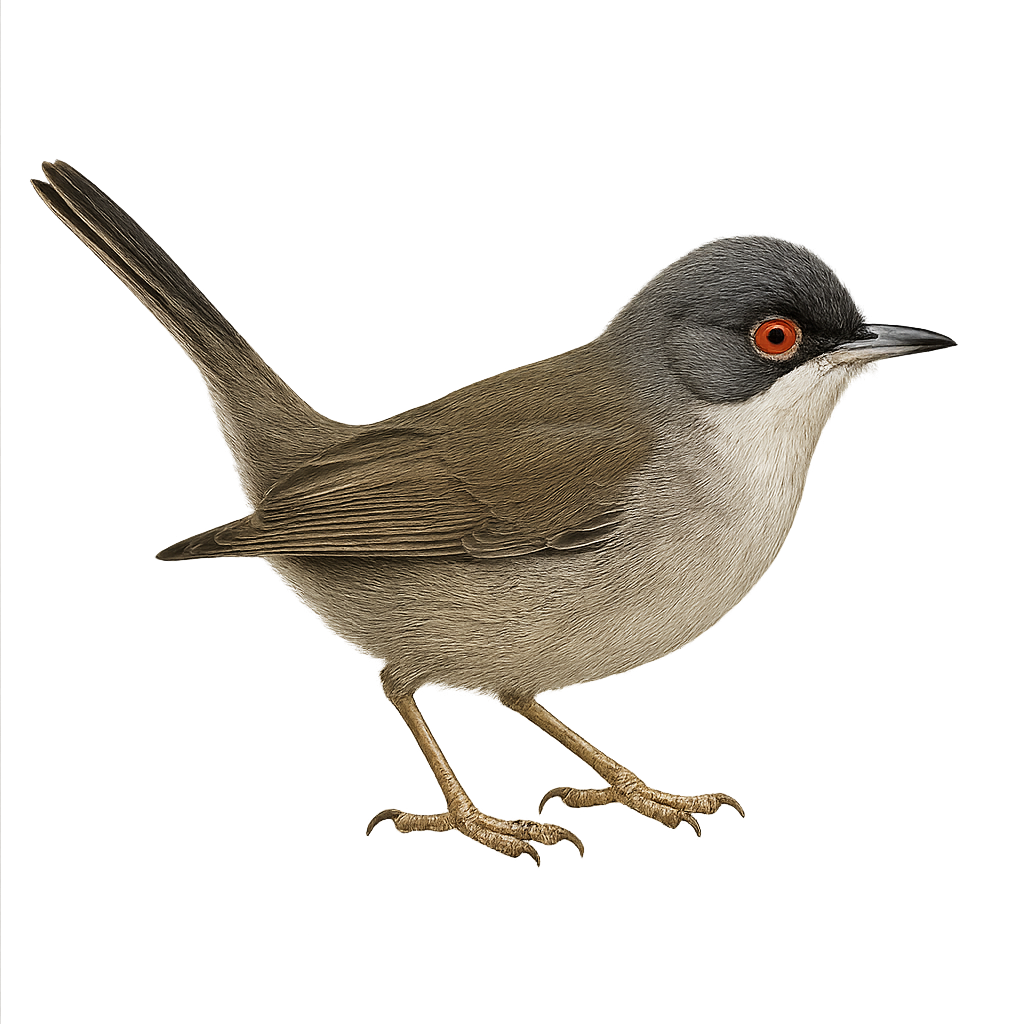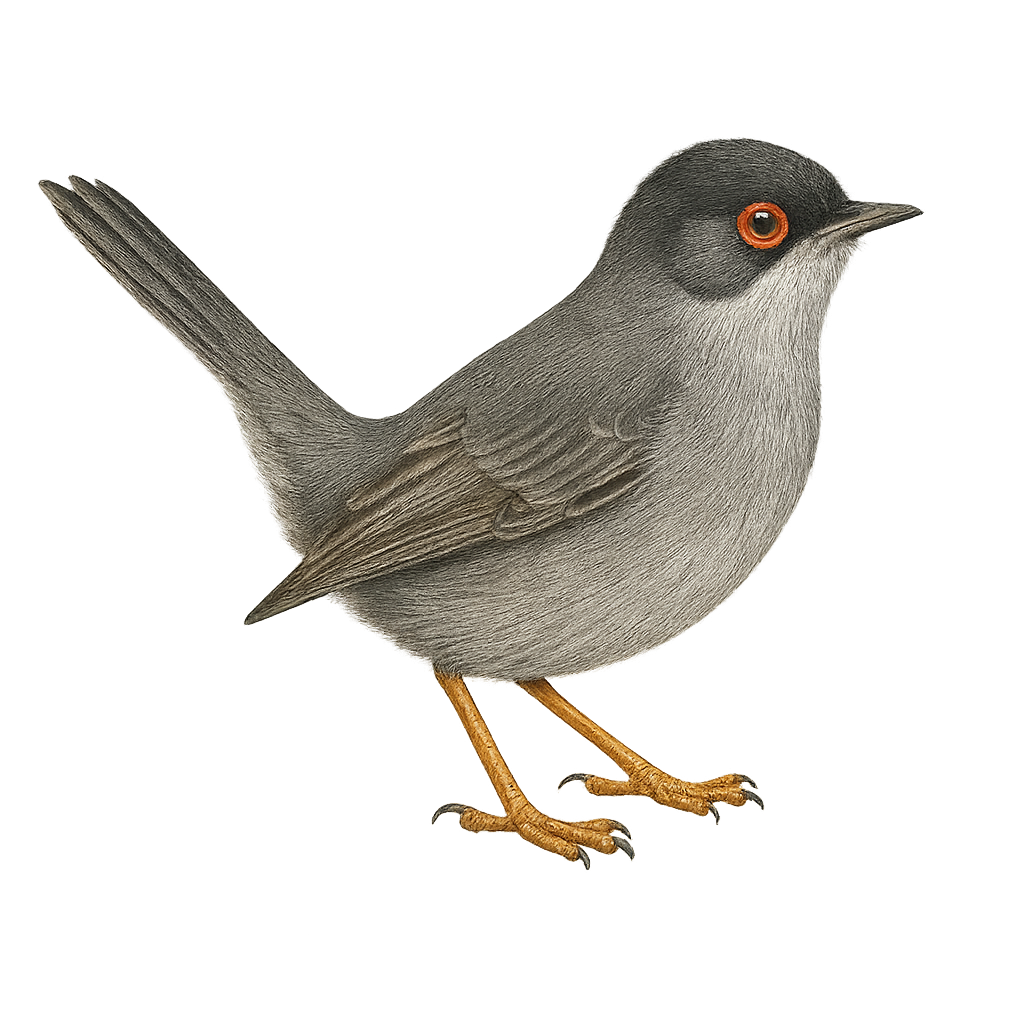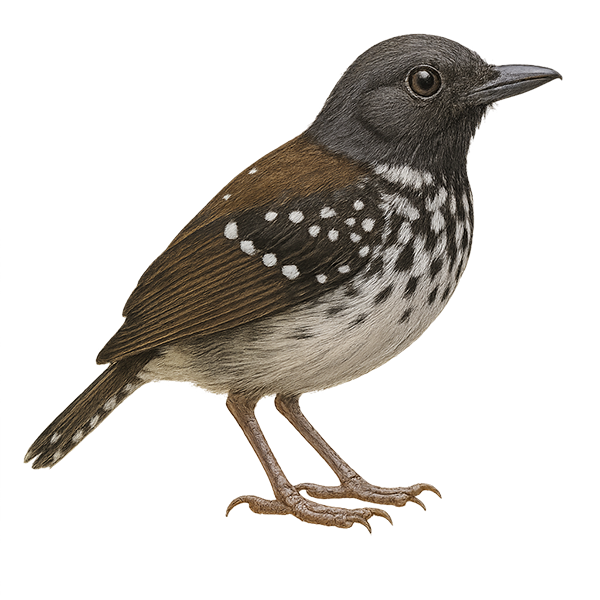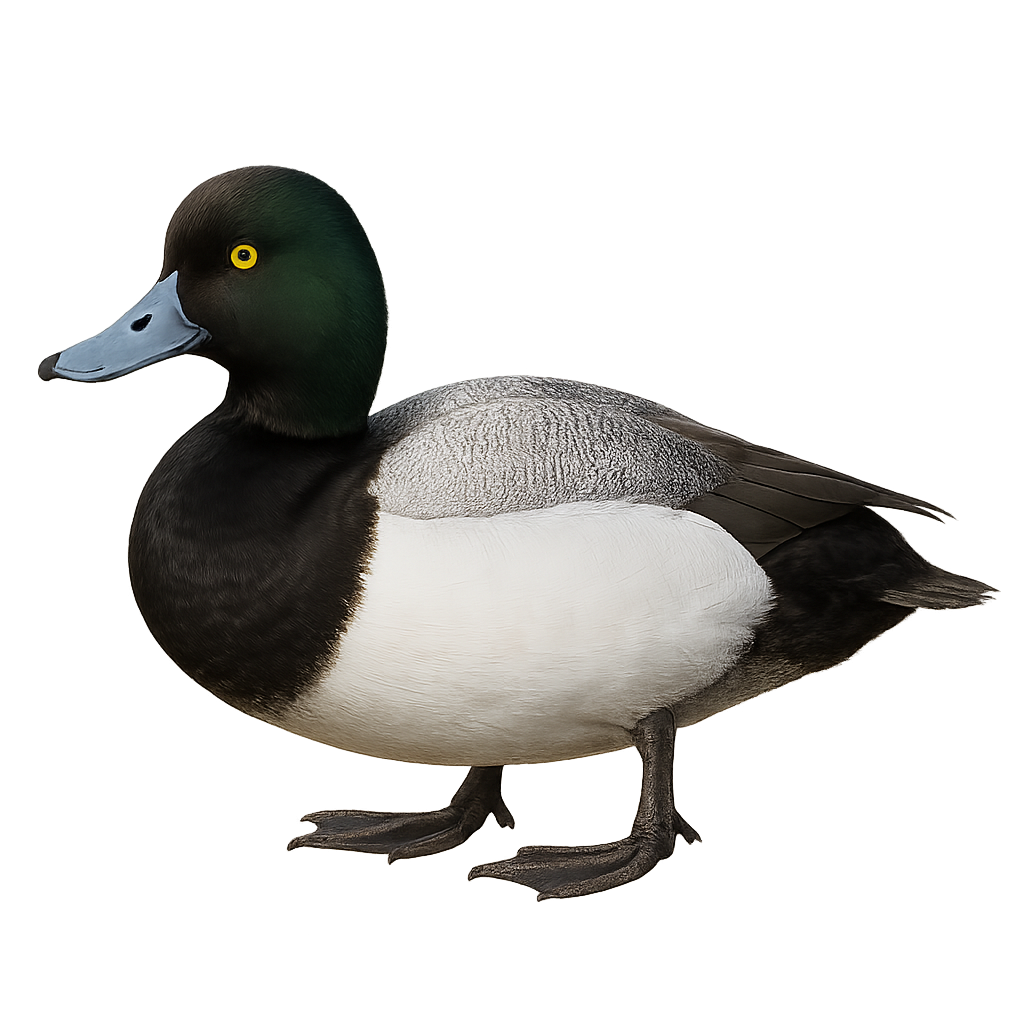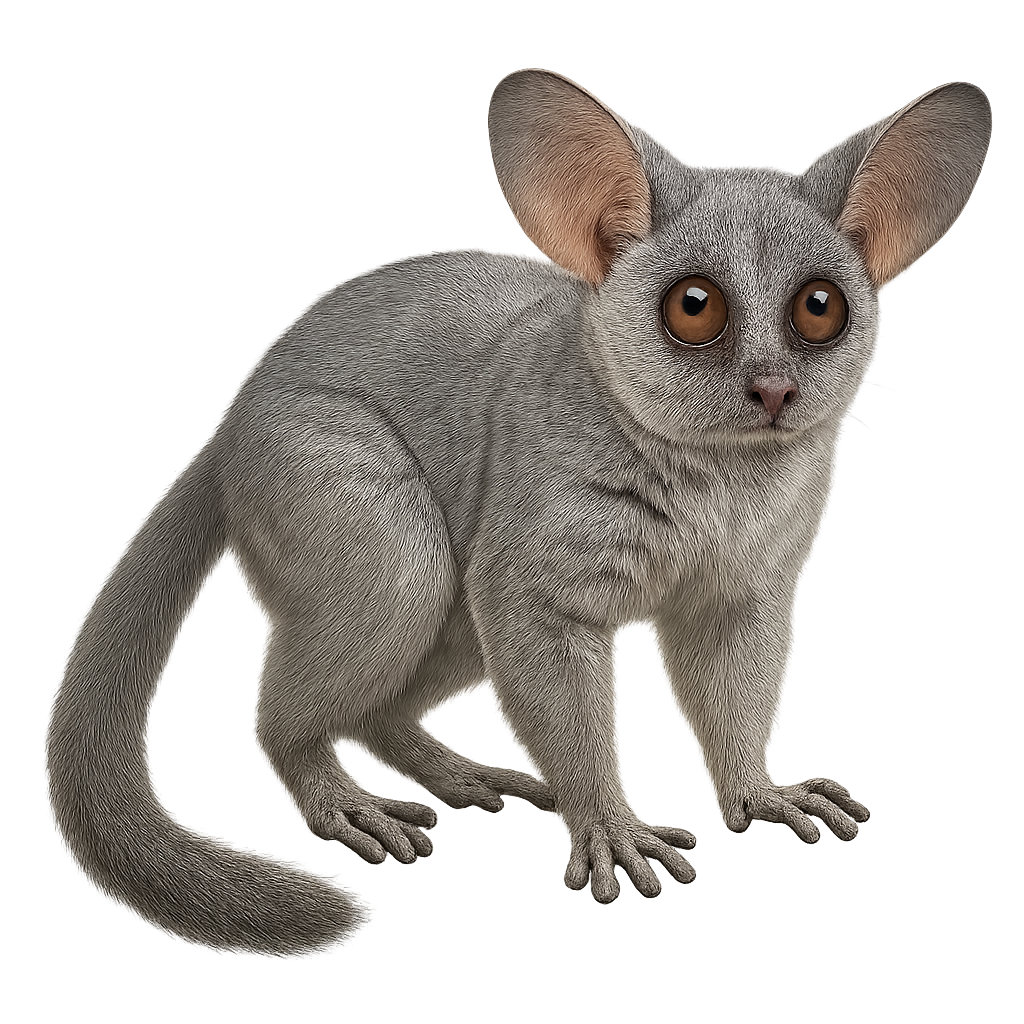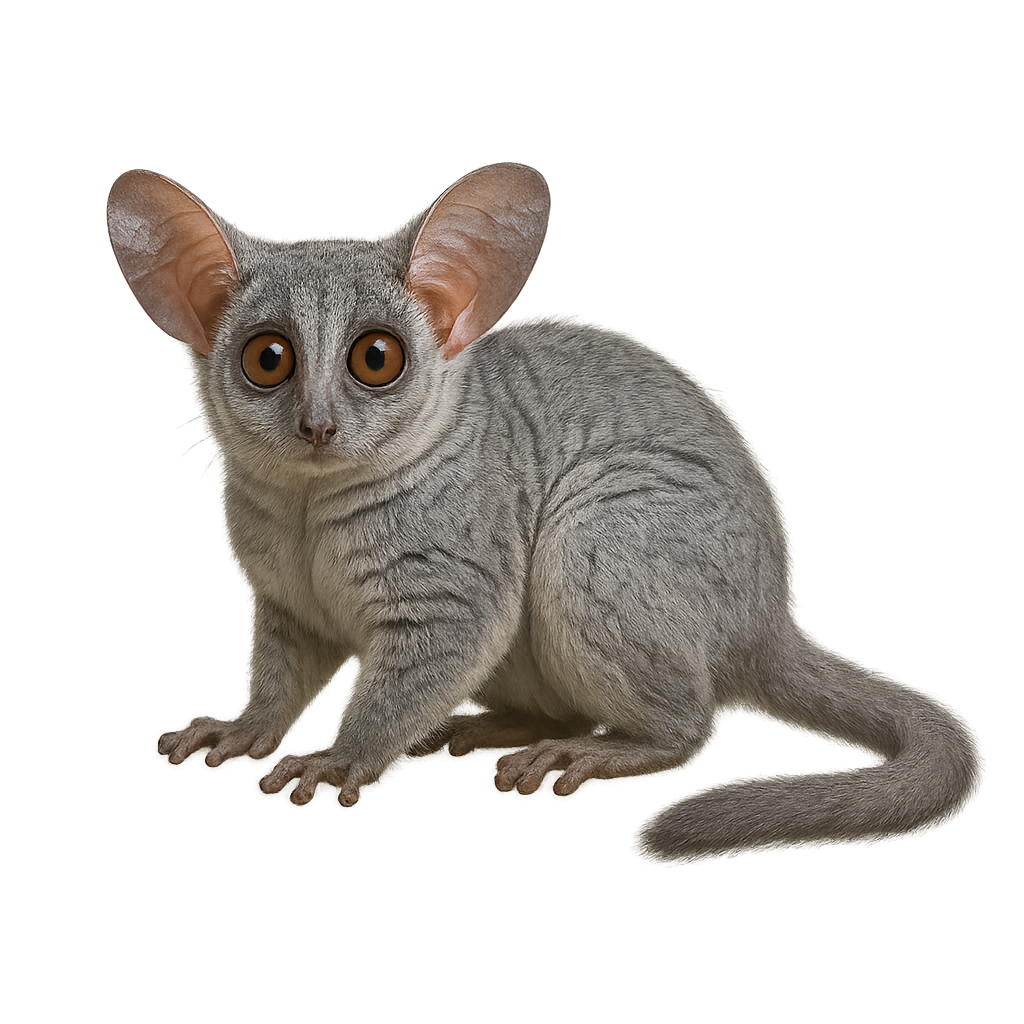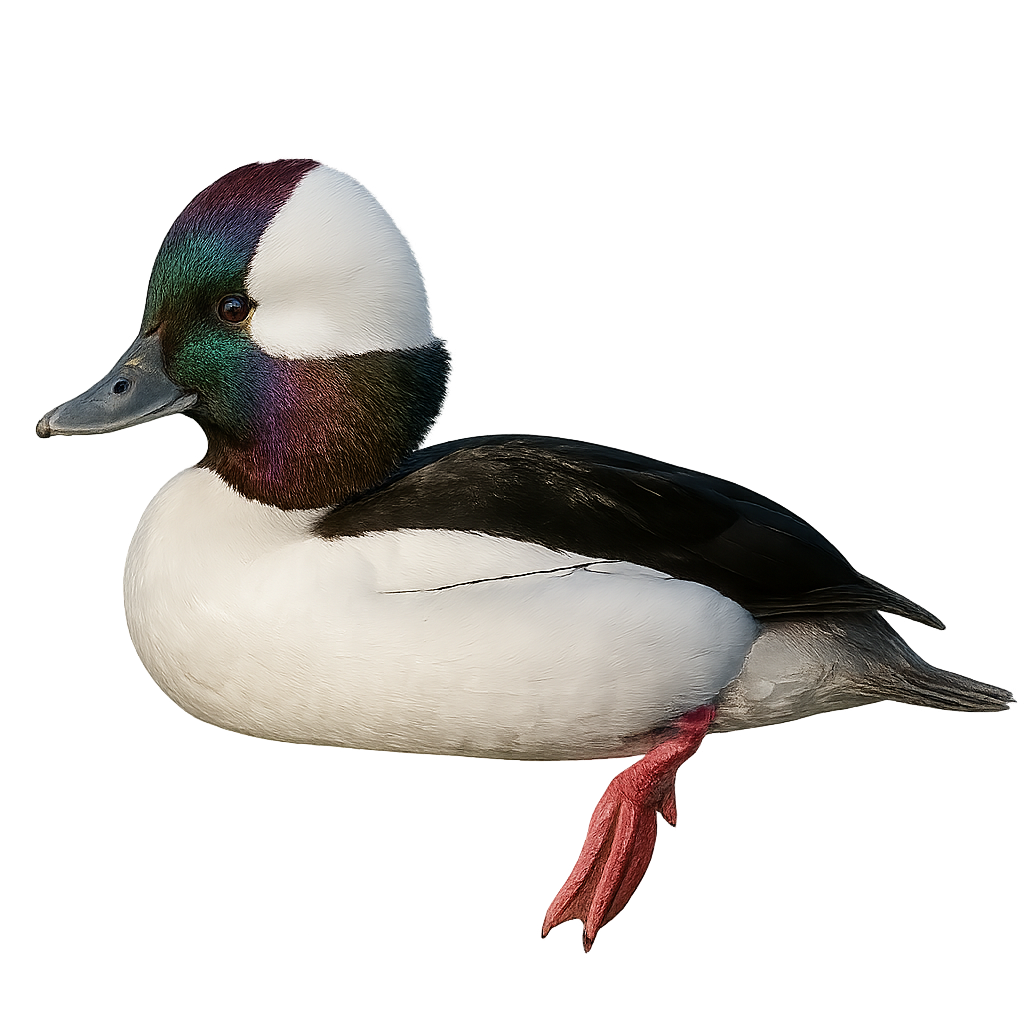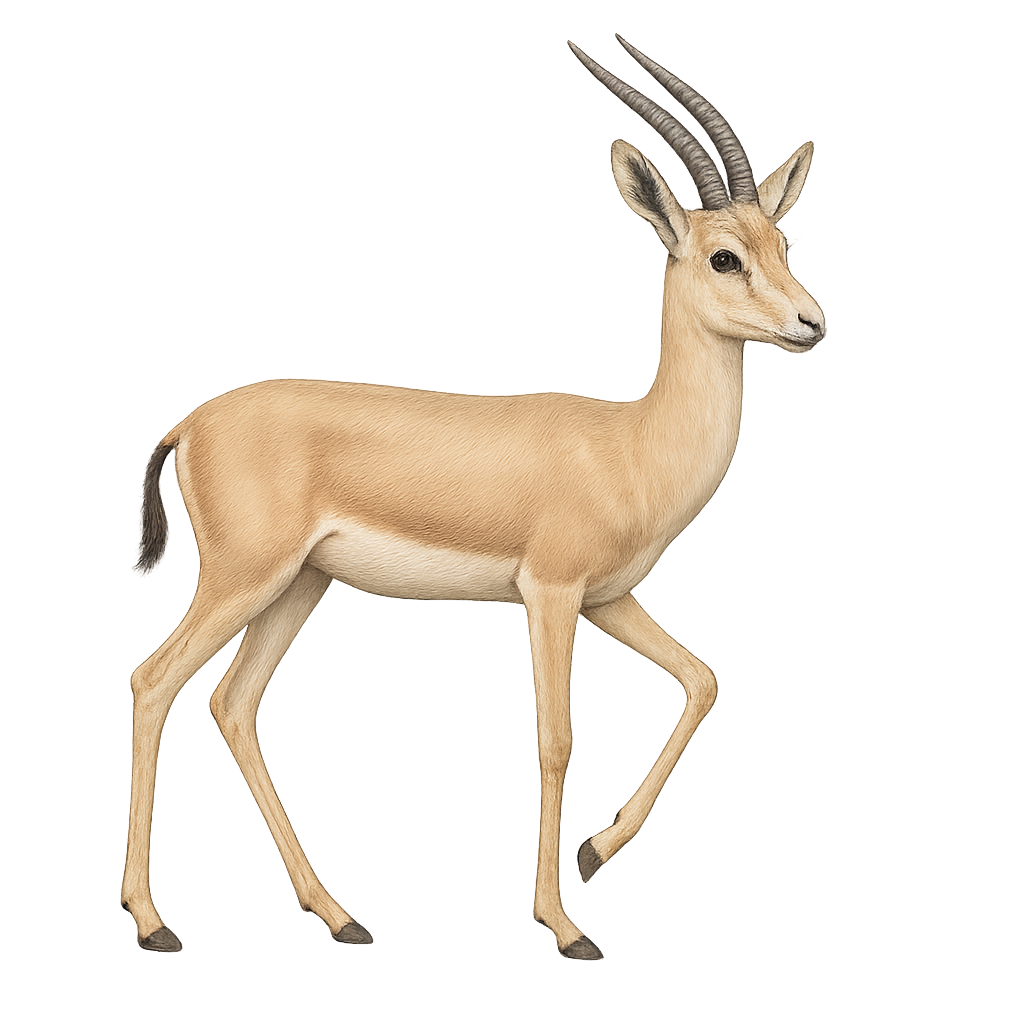The Sirena Poison Frog, Ranitomeya sirensis, is a small, brightly colored frog native to the humid tropical forests of Peru. Known for its vivid colors, which range from blue to black with yellow or red patterns, it serves as a warning to potential predators of its toxicity. Measuring about 2 cm in length, this species is diurnal and primarily feeds on small insects. It inhabits lowland areas, often near water bodies. Its skin secretes toxic alkaloids, used by local populations to poison arrows. Although its population is stable, it is threatened by deforestation and the illegal exotic pet trade.
The Steyermark's Poison Frog is a small, brightly colored frog endemic to the tropical forests of Venezuela. It is characterized by its vivid skin, often red or orange with black spots, which serves as a warning to potential predators due to its potent toxins. Measuring about 2 cm, it is primarily terrestrial and feeds on small insects. Its natural habitat is threatened by deforestation, making it a vulnerable species. It plays a crucial role in the ecosystem by controlling insect populations. Its reproduction is complex, involving parental care where tadpoles are transported on the adults' backs to water bodies.
The Summers' Poison Frog, or Ranitomeya summersi, is a small, brightly colored frog native to the tropical forests of Peru. It is known for its vivid colors, ranging from blue to black with yellow or orange patterns. This species is often found in humid areas and dense forests, where it hides under leaves and debris. It is diurnal and spends most of its time foraging for food, primarily insects. Due to its small size, it is vulnerable to predators, but its bright colors serve as a warning of its toxicity. Conservation of its natural habitat is crucial for its survival, as deforestation threatens its populations.

The Strawberry Poison Dart Frog is a small, vibrant, and colorful frog from the Dendrobatidae family. This species typically measures between 2 and 3 centimeters in length and is easily recognizable by its bright red or orange color, sometimes speckled with blue or black, hence its name "strawberry." It is primarily found in the humid tropical forests of Central America, particularly in Costa Rica and Panama. Its diet mainly consists of ants, spiders, and other small arthropods, which it primarily captures from the forest floor. The bright coloration of its skin is an indicator of its toxicity, which comes from alkaloids found in its diet, particularly ants. These toxins serve as protection against predators. During the breeding season, the Strawberry Poison Dart Frog lays its eggs on the forest floor or in humid areas where the tadpoles develop, often in small pools of water or tiny puddles. While this species is not in immediate danger, it is threatened by deforestation, habitat loss, and pollution.
The Splendid Poison Frog, Oophaga speciosa, is a tree-dwelling frog species known for its vibrant and toxic skin. Native to the humid rainforests of Central America, it is distinguished by its bright colors ranging from vivid red to deep blue, a warning to predators of its toxicity. This frog typically measures between 2 and 4 cm in length. It primarily feeds on small insects and arthropods. Males are territorial and use vocal calls to attract females and deter rivals. Reproduction involves parental care, with eggs laid on the forest floor and tadpoles transported on the adults' backs to water bodies.
The Sharp-winged Tyrannulet is a small passerine bird from the Tyrannidae family, known for its pointed wings and subtle plumage. It primarily inhabits wetlands and marshes in South America, especially in Argentina, Paraguay, and Uruguay. Its song is melodious, although it is often hard to spot due to its small size and discreet behavior. It mainly feeds on insects, catching them in flight or on leaves. The breeding season varies by region but typically occurs in spring. Nests are often built in low shrubs, hidden from predators.
The Sclater's Tyrannulet is a small passerine bird belonging to the Tyrannidae family. It is primarily found in the wetlands and marshes of South America, particularly in Argentina, Bolivia, and Paraguay. This bird is characterized by its olive-brown plumage, with lighter shades on the belly and slightly striped wings. Its modest size and discreet behavior sometimes make it difficult to spot. It primarily feeds on insects, which it catches in flight or on vegetation. The Sclater's Tyrannulet is known for its melodious songs, often heard at dawn. Although not considered threatened, habitat degradation could pose long-term risks.
The short-beaked echidna is a small monotreme mammal, 30–45 cm long, covered in spines with an elongated head bearing a long tubular snout. Endemic to Australia and New Guinea, it inhabits forests, scrublands and open areas, feeding mainly on ants and termites with its fast, sticky tongue. Solitary, it alternates nocturnal and crepuscular activity phases to avoid heat.
The Spectacled Eider (Somateria fischeri) is a striking sea duck found in Arctic regions, especially along the coasts of Alaska and eastern Siberia. This medium-sized duck is named for the distinctive black "spectacle" markings around the male's eyes, set against a pale cream head, with a greenish nape and bright orange bill. The female is more subdued in appearance, with a uniform brown plumage that blends well into coastal surroundings. Spectacled Eiders are typically seen in small groups, diving in shallow waters for mollusks, crustaceans, and sea urchins. Though rare and considered vulnerable, this unique bird captivates those lucky enough to spot it in the wild.
The Steller's Eider is a distinctive sea duck known for its striking plumage and migratory habits. Males display a striking breeding plumage with a white head, black eye patches, and a brown and black body. Females are more subdued, primarily brown, allowing them to blend into their natural habitat. These birds breed in the Arctic regions of Russia and Alaska, often nesting near lakes and rivers. In winter, they migrate to more temperate coasts, where they primarily feed on mollusks and crustaceans. The Steller's Eider is a vulnerable species, threatened by habitat loss and climate change.
The Small-billed Elaenia is a small passerine bird belonging to the Tyrannidae family. It is primarily found in South America, especially in wooded areas and savannas. This bird is characterized by its olive-gray plumage on the back and lighter underparts, as well as its relatively short bill, which gives it its name. Small-billed Elaenias are often seen feeding on insects and fruits, which they catch in flight or on branches. Their song is a key element of their communication, often described as a soft and melodious whistle. Although generally discreet, they can be observed in small groups or pairs.
The Small-billed Elaenia is a small passerine bird belonging to the Tyrannidae family. It is primarily found in the subtropical and tropical moist forests of South America, particularly in Brazil, Argentina, and Paraguay. This bird is characterized by its olive-gray back and white belly, which gives it its name. It has a relatively short bill and dark eyes. The Small-billed Elaenia is an active bird, often seen foraging for insects and fruits in the canopy. Its song is a key element for identification, consisting of a series of high-pitched, repetitive notes. Although not currently threatened, deforestation poses a potential risk to its natural habitat.
Large marine mammal in the family Phocidae, reaching up to 3.5 m in length and 600 kg in weight. It inhabits Antarctic and subantarctic coastal waters, feeding mainly on fish, cephalopods and juvenile seals. During the breeding season, females give birth to a single pup on the ice or beach and nurse it for about three weeks.
The Sharp-shinned Hawk, a small raptor from the Accipitridae family, is an agile and swift hunter often seen in the dense forests of North America. It is characterized by its modest size, short rounded wings, and long barred tail. Its plumage is typically blue-gray above and rufous-streaked below. This predator primarily feeds on small birds, capturing them in flight with its acrobatic flying skills. Although discreet, it is sometimes spotted during its seasonal migrations. The Sharp-shinned Hawk plays a crucial role in controlling smaller bird populations, thus contributing to the ecological balance of its habitat.
The Stripe-throated Hermit, or Phaethornis striigularis, is a small hummingbird native to the tropical rainforests of Central and South America. This tiny bird, measuring about 10 to 12 cm in length, is recognizable by its brown-green plumage and white-striped throat. It has a long, curved bill, perfect for feeding on the nectar of tubular flowers. Males and females look similar, although males often have slightly brighter colors. The Stripe-throated Hermit is a solitary bird, often seen darting quickly from flower to flower. It plays a crucial role in the pollination of tropical plants.
The Spot-backed Hermit, or Ramphodon naevius, is a fascinating hummingbird native to the humid tropical forests of southeastern Brazil. This small bird is distinguished by its brown-green plumage with white spots on its back, giving it a unique appearance. Its long, curved beak is perfectly adapted for feeding on the nectar of tubular flowers, a common trait among hummingbirds. The Spot-backed Hermit is often observed flying quickly from flower to flower, playing a crucial role in the pollination of local plants. Although primarily solitary, it can sometimes be seen in small groups during the breeding season. Its ability to adapt to different habitats, including secondary forests and gardens, makes it a resilient species despite deforestation threats.
The Spotless Starling is a medium-sized bird, measuring about 21 to 23 cm in length with a wingspan of 37 to 42 cm. Its plumage is predominantly black with metallic green and purple sheens, distinguishing it from the common starling. It is endemic to the Iberian Peninsula and northwest Africa. This bird is often seen in flocks, especially outside the breeding season. It inhabits various environments, including agricultural areas, urban parks, and open woodlands. Its diet is diverse, consisting of insects, fruits, and seeds. The Spotless Starling is known for its melodious song and ability to mimic other sounds.
The Southern Red Bishop, scientifically known as Euplectes orix, is a small passerine bird belonging to the Ploceidae family. It is easily identifiable by its striking plumage, particularly in breeding males, which display a vibrant red contrasted with black. Females and non-breeding males are duller, with brownish hues. This bird is primarily found in sub-Saharan Africa, frequenting marshes, wet grasslands, and cultivated areas. It is renowned for its spectacular courtship displays, where the male puffs up its feathers to attract females. The Southern Red Bishop primarily feeds on seeds, but also consumes insects, especially during the breeding season.
The Silver Pheasant, Lophura nycthemera, is an elegant and majestic bird native to the forests of Southeast Asia. It is easily recognizable by its silvery-white plumage in males, contrasting with its long tail and red legs. The female, more discreet, has brown plumage. These birds prefer dense, humid forests, where they feed on seeds, fruits, and insects. Their behavior is generally suspicious, but they can become accustomed to human presence in protected areas. The Silver Pheasant plays an important role in its ecosystem by dispersing seeds and controlling insect populations.
The Swinhoe's Pheasant, Lophura swinhoii, is an endemic species of pheasant found in Taiwan. This stunning bird is easily identifiable by its striking plumage: the male boasts a metallic blue coat with greenish hues, a long white tail, and red wattles around the eyes. The female is more subdued, with a primarily brown plumage and subtle patterns. This pheasant primarily inhabits the mountainous forests of the island, favoring dense and humid areas. It is often seen foraging on the ground, feeding mainly on seeds, fruits, and insects. Although its habitat is limited, it is relatively common in protected areas.
The Sardinian warbler is a small passerine bird found primarily in scrublands, maquis, and Mediterranean regions. It is easily recognized by its light gray plumage, brown back, and pale belly. This bird is primarily insectivorous, feeding on small prey such as insects and spiders, which it captures by rummaging through bushes and vegetation. It is also known for its melodious song and discreet movements in the underbrush.
The Sardinian Warbler, Sylvia melanocephala, is a small passerine bird belonging to the Sylviidae family. It is easily identified by the male's black cap, contrasting with its grey body and white underparts. The female has a brownish cap. This bird is mainly sedentary and is found in the Mediterranean basin, where it inhabits scrublands, garrigues, and bushy areas. The Sardinian Warbler is an active bird, often seen moving quickly through dense vegetation in search of insects and berries. Its song is a rapid, repetitive trill, often heard in spring. Although relatively discreet, it can be observed year-round in its natural habitat.
The Sardinian Warbler, or Sylvia sarda, is a small passerine bird belonging to the Sylviidae family. It is mainly found in Mediterranean regions, particularly in Corsica and Sardinia. This bird is characterized by its grayish plumage, with a black cap on males and a browner cap on females. Its song is melodious and varied, often heard in scrublands and garrigues where it hides among dense bushes. The Sardinian Warbler is a sedentary bird, although it may undertake small altitudinal migrations. It primarily feeds on insects and berries found in its natural habitat. Although its conservation status is currently stable, habitat degradation could pose a future threat.
The Beech Marten is a small carnivorous mammal belonging to the mustelid family. It measures between 40 and 50 cm in length, with a tail that can reach up to 30 cm, and typically weighs between 1.5 and 2 kg. Its fur is dense and smooth, typically brown in color, with a lighter belly and a distinctive white patch on the throat. The Beech Marten is agile and opportunistic, primarily hunting small mammals, birds, eggs, as well as fruits and insects. It is mainly nocturnal and solitary, but can be observed in a wide variety of habitats, including forests, orchards, and even urban areas. It is known for its ability to climb trees and enter attics and lofts of human dwellings. While the Beech Marten is relatively common in Europe, it faces threats related to habitat loss and human activities, such as road traffic and deforestation.
The Spot-backed Antbird is a small bird from the Thamnophilidae family, primarily found in the humid tropical forests of South America. It is recognizable by its brown plumage with distinctive white spots on its back and wings. This bird is often seen in pairs or small groups, moving through the underbrush in search of insects and other small invertebrates. Known for its melodious and repetitive song, it resonates throughout the forest. Although relatively discreet, it can be spotted thanks to its characteristic calls. The Spot-backed Antbird plays an important role in the forest ecosystem by controlling insect populations and participating in seed dispersal.
The scaup is a diving duck found primarily in lakes, ponds, and wetlands across Europe, Asia, and North America. It is easily recognizable by its contrasting black and white plumage, blue-green beak, and rounded head. This duck primarily feeds on aquatic plants and small invertebrates, which it captures by diving underwater. During the breeding season, it builds its nest in aquatic vegetation or near the shores.
The Senegal Bushbaby, also known as the Senegal Galago, is a small nocturnal primate found primarily in the wooded regions and savannas of West and East Africa. It is easily recognizable by its large, round eyes adapted for night vision and its long hind legs that allow it to leap agilely from tree to tree. Its fur is soft and dense, usually gray or brownish, with a lighter belly. This primate is mainly insectivorous but also feeds on fruits and acacia gum. The galago is a social animal that communicates through high-pitched calls and uses its keen sense of smell to mark its territory.
The Senegal bush baby, also known as Galago moholi, is a small nocturnal primate native to the forests and savannas of West Africa, particularly Senegal and Gambia. This primate is easily recognized by its large eyes, pointed ears, and silky fur. It primarily feeds on insects, fruits, and nectar. The Senegal bush baby is an excellent climber and moves quickly from tree to tree using its long legs and prehensile tail. It is a social animal, often living in small groups, and is mainly active at night, using powerful vocalizations to communicate.
The smew is a small diving duck, 38–42 cm long, with the male’s striking black-and-white plumage and the female’s more subdued brownish tones. It inhabits lakes, ponds, and calm rivers with riparian vegetation in boreal and temperate regions. An expert diver, it feeds on small fish and aquatic invertebrates.
The slender-horned gazelle, or Gazella leptoceros, is a species of gazelle that primarily inhabits the desert regions of the Sahara. It is recognizable by its slender, elongated horns, which can reach up to 40 cm in length. Its coat is pale, almost white, allowing it to blend into the sandy dunes. This gazelle is well adapted to its arid environment, capable of surviving with very little water, feeding mainly on leaves, shoots, and fruits. Unfortunately, it is critically endangered due to excessive hunting and habitat degradation.


